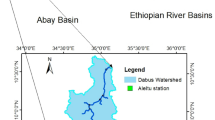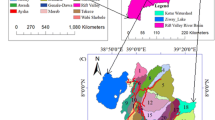Abstract
The present study analyzes the runoff response during extreme rain events over the basin of Subarnarekha River in India using soil and water assessment tool (SWAT). The SWAT model is configured for the Subarnarekha River basin with 32 sub-basins. Three gauging stations in the basin (viz., Adityapur, Jamshedpur and Ghatshila) were selected to assess the model performance. Daily stream flow data are taken from Central Water Commission, India—Water Resources Information System. Calibration and validation of the model were performed using the soil and water assessment tool-calibration uncertainty programs (SWAT-CUPs) with sequential uncertainty fitting (SUFI-2) algorithm. The model was run for the period from 1982 to 2011 with a calibration period from 1982 to 1997 and a validation period from 1998 to 2011. The sensitivity of basin parameters has been analyzed in order to improve the runoff simulation efficiency of the model. The study concluded that the model performed well in Ghatshila gauging station with a Nash–Sutcliffe efficiency (NSE) of 0.68 during calibration and 0.62 during validation at daily scale. The model, thus calibrated and validated, was then applied to evaluate the extreme monsoon rain events in recent years. Five extreme events were identified in Jamshedpur and Ghatshila sub-basins of Subarnarekha River basin. The simulation results were found to be good for the extreme events with the NSE of 0.89 at Jamshedpur and 0.96 at Ghatshila gauging stations. The findings of this study can be useful in runoff simulation and flood forecasting for extreme rainfall events in Subarnarekha River basin.









Similar content being viewed by others
References
Abbaspour KC (2011) SWAT-CUP4: SWAT calibration and uncertainty programs—a user manual. Swiss Federal Institute of Aquatic Science and Technology, Eawag
Abbaspour KC, Yang J, Maximov I, Siber R, Bogner K, Mieleitner J, Zobrist J, Srinivasan R (2007) Spatially distributed modelling of hydrology and water quality in the pre-alpine/alpine Thur watershed using SWAT. J Hydrol 333:413–430
Arnell NW (1996) Global warming, river flows and water resources. Wiley, Chichester
Arnold JG, Srinivasan R, Muttiah RS, Williams JR (1998) Large area hydrologic modeling and assessment part I: model development. JAWRA J Am Water Resour Assoc 34(1):73–89
Beven KJ (2001) In: rainfall-runoff modelling. Wiley, Chichester, pp 217–225
Borah DK, Bera M, Xia R (2004) Storm event flow and sediment simulations in agricultural watersheds using DWSM. Trans ASAE 47(5):1539
Centre for Science and Environment (CSE) Report (2014) Society of Environmental Communication. Centre for Science and Environment (CSE) Report, New Delhi
Chaturvedi RK, Joshi J, Jayaraman M, Bala G, Ravindranath NH (2012) Multi-model climate change projections for India under representative concentration pathways. Curr Sci 103:791–802
Chow VT, Maidment DR, Mays LW (1988) Applied hydrology. McGraw-Hill Inc, New York
Cibin R, Chanbey I, Engel B (2012) Simulated watershed scale impacts of corn stove removal for biofuel on hydrology and water quality. Hydrol. Process 26(11):1629–1641. https://doi.org/10.1002/hyp.8280
Daggupati P, Pai N, Ale S Douglas-Mankin KR, Zeckoski R, Jeong J, Parajuli PB, Saraswat D, Youssef MA (2015) Recommended calibration and validation strategy for hydrologic and water quality models. Trans ASABE 58(6):1705–1719
Dile YT, Srinivasan R (2014) Evaluation of CFSR climate data for hydrologic prediction in data-scarce watersheds: an application in the Blue Nile River Basin. J Am Water Resour As 50:1226–1241. https://doi.org/10.1111/jawr.12182
Fischer EM, Knutti R (2014) Detection of spatially aggregated changes in temperature and precipitation extremes. Geophys Res Lett 41(2):547–554
Groisman PY, Knight RW, Easterling DR, Karl TR, Hegerl GC, Razuvaev VN (2005) Trends in intense precipitation in the climate record. J Clim 18(9):1326–1350
Hamby DM (1994) A review of techniques for parameter sensitivity analysis of environmental models. Environ Monit Assess 32:135–154
Huntington TG (2006) Evidence for intensification of the global water cycle: review and synthesis. J Hydrol 319:83–95
Jha M, Arnold JG, Gassman PW, Giorgi F, Gu RR (2006) Climate chhange sensitivity assessment on upper mississippi river basin streamflows using SWAT. JAWRA J Am Water Resour Assoc 42(4):997–1015
Joh HK, Lee JW, Park MJ, Shin HJ, Yi JE, Kim GS, Srinivasan R, Kim SJ (2011) Assessing climate change impact on hydrological components of a small forest watershed through SWAT calibration of evapotranspiration and soil moisture. Trans ASABE 54(5):1773–1781
Kannan N, White SM, Worrall F, Whelan MJ (2007) Sensitivity analysis and identification of the best evapotranspiration and runoff options for hydrological modelling in SWAT-2000. J Hydrol 332(3–4):456–466
Krishnakumar SK, Patwardhan A, Kulkarni K, Kamala K, Rao Koteswara, Jones R (2011) Simulated projections for summer monsoon climate over India by a high-resolution regional climate model (PRECIS). Curr Sci 101:312–325
Krishnamurthy V (2012) Extreme events and trends in the Indian summer monsoon. In: Surjalal A, Bunde A, Dimri VP, Baker DN (eds) Extreme events and natural hazards: the complexity perspectives. American Geophysical Union, Washington, DC
Moriasi DN, Arnold JG, Van Liew MW, Bingner RL, Harmel RD, Veith TL (2007) Model evaluation guidelines for systematic quantification of accuracy in watershed simulations. Trans ASABE 50(3):885–900
Nash JE, Sutcliffe JV (1970) River flow forecasting through conceptual models part I—a discussion of principles. J Hydrol 10(3):282–290
Neitsch SL, Arnold, JG, Kiniri JR and Williams JR (2011) Soil water assessment tool theoretical documentation version 9, Texas water resource institute of technical report. No. 406, Texas A&M University
Pai DS, Sridhar L, Rajeevan M, Sreejith OP, Satbhai NS, and Mukhopadhyay B (2013) Development and analysis of a new high spatial resolution (0.25° × 0.25°) 20 long period (1901–2010) daily gridded rainfall data set over India. National climate centre research report No. 1/2013, India Meteorological Department, Pune, India
Pai DS, Sridhar L, Rajeevan M, Sreejith OP, Satbhai NS, Mukhopadhyay B (2014) Development of a new high spatial resolution (0.25° × 0.25°) long period (1901–2010) daily gridded rainfall data set over India and its comparison with existing data sets over the region. Mausam 65:1–18
Sevat E, Dezetter A (1991) Selection of calibration objective functions in the context of rainfall-runoff modeling in a Sudanese savannah area. Hydrol Sci J 36(4):307–330
Sharma R, Goswami SB and Kar SC (2015) Evaluation of daily rainfall runoff simulations in Narmada River Basin. Int J Earth Sci Eng 8:3. ISSN 0974-5904
Sharmila S, Joseph S, Sahai AK, Abhilash S, Chattopadhyay R (2015) Future projection of Indian summer monsoon variability under climate change scenario: An assessment from CMIP5 climate models. Glob Planet Change 124:62–78
Shrestha PM, Rotaru AE, Aklujkar M, Liu F, Shrestha M, Summers ZM, Malvankar N, Flores DC, Lovley DR (2013) Syntrophic growth with direct interspecies electron transfer as the primary mechanism for energy exchange. Environ Microbiol Rep 5(6):904–910
Sorland SL, Sorteberg A (2015) The dynamic and thermodynamic structure of monsoon low-pressure systems during extreme rainfall events. Tellus A Dyn Meteorol Oceanogr 67(1):27039
Trenbert KE (2006) The impact of climate change and variability on heavy precipitation, floods, and droughts: encyclopedia of hydrological sciences. Wiley, New York
Uniyal B, Jha MK, Verma AK (2015) Parameter identification and uncertainty analysis for simulating streamflow in a river basin of Eastern India. Hydrol Process 29(17):3744–3766. https://doi.org/10.1002/hyp.10446
U.S. Department of Agriculture, Soil Conservation Service (1972) National engineering handbook. Hydrology section 4. Chapters 4–10. USDA, Washington, DC
van Griensven A, Meixner T, Grunwald S, Bishop T, Diluzio M, Srinivasan R (2006) A global sensitivity analysis tool for the parameters of multi-variable catchment models. J Hydrol 324(1–4):10–23
Van Liew MW, Arnold J, Garbrecht JD (2003) Hydrologic simulation on agricultural watersheds: choosing between two models. Trans Am Soc Agric Eng 46(6):1539–1551
White KL, Chaubey I (2005) Sensitivity analysis, calibration, and validations for a multisite and multivariable SWAT model. JAWRA J Am Water Resour Assoc 41(5):1077–1089
Yang J, Reichert P, Abbaspour KC, Xia J, Yang H (2008) Comparing uncertainty analysis techniques for a SWAT application to the Chaohe Basin in China. J Hydrol 358(1–2):1–23
Acknowledgements
This work was carried out at National Centre for Medium Range Weather Forecasting (NCMRWF), Noida, UP, India, when one of the authors (AY) visited the Centre. The computational resources used in study were made available through the Modeling of Changing Water Cycle and Climate project of the Ministry of Earth Sciences at NCMRWF.
Author information
Authors and Affiliations
Corresponding author
Rights and permissions
About this article
Cite this article
Yaduvanshi, A., Sharma, R.K., Kar, S.C. et al. Rainfall–runoff simulations of extreme monsoon rainfall events in a tropical river basin of India. Nat Hazards 90, 843–861 (2018). https://doi.org/10.1007/s11069-017-3075-0
Received:
Accepted:
Published:
Issue Date:
DOI: https://doi.org/10.1007/s11069-017-3075-0




